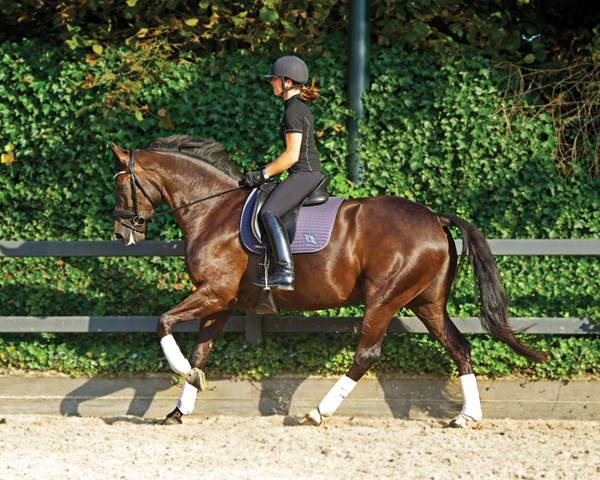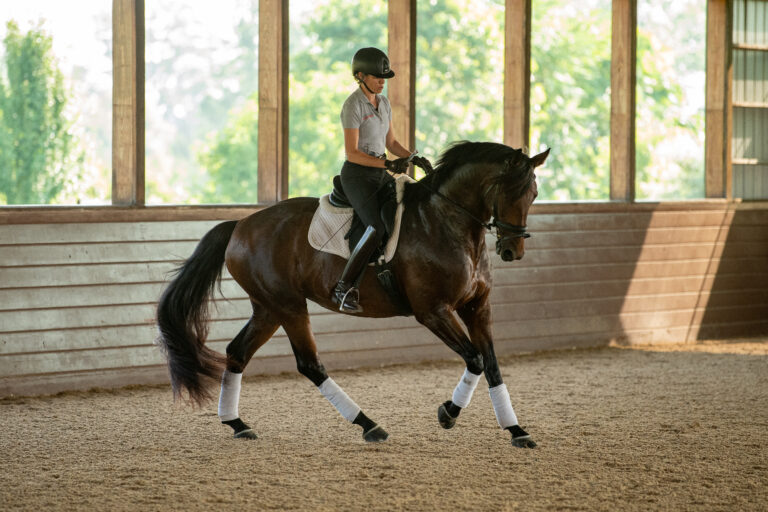Q: One of the comments I received in my last test was that my horse shouldn’t jump into the canter. This completely confused me. How is a horse supposed to canter on? How would you like to see an upward transition into the canter?—Jo Barbour of Redmont, Washington
A: It is understandable that you might be confused by the comment “shouldn’t jump into the canter.” The canter is a jumping movement. When the hind legs are sluggish due to a lack of engagement, judges may suggest the quality of the canter would improve with more jump behind.

In response to your question about how I would like to see an upward transition into the canter, I will reference the USEF Rulebook, which reads: “The changes of pace should be clearly shown at the prescribed marker, they should be quickly made yet must be smooth, not abrupt. The cadence of the pace must be maintained up to the moment when the gait or pace is changed or the horse halts. The horse should remain light in hand, calm and maintain correct position.”
There is more to riding a canter transition than just giving the canter aid. It is important to establish a quality trot or walk first. The horse must be working in a steady rhythm with a forward attitude and the degree of suppleness, contact and straightness relative to his level of training. In order to execute a transition with harmony, lightness and ease, you must have a secure, balanced, deep seat and independent hands with the ability to follow the movement.
Preparation is the key to achieving balanced, fluid transitions. In preparation, your horse must respond to a balancing half halt. You should feel a slight shift of weight to the hindquarters with your horse stepping under, rounding his back and lightening his forehand. The horse is now re-balanced, on the aids and capable of a calm, fluid transition.
Half halting is important before every transition you ride. It serves three purposes that directly relate to the section of the Rulebook previously quoted:
1. “Transitions should be quickly made yet must be smooth not abrupt.” Horses hate to be surprised. The half halt acts as a wake-up call, warning the horse that he is about to be asked for a transition. The horse will be ready to respond to a quieter, softer aid, enabling a smooth transition. Too strong an aid or over-riding causes the horse to overreact, resulting in an abrupt transition with the horse hollowing his back and coming above the bit or “jumping into the canter.”
2. “The cadence of the pace must be maintained up to the moment when the pace or gait changes.” The trot quickening or the walk becoming tense and lateral when asked for a canter transition is a common fault. It is important to maintain a balanced, energetic trot or walk without altering the tempo. Balancing half halts will help to regulate the tempo.
3. “The horse must remain light in hand, calm and maintain correct position.” The half halts keep your horse relaxed and create the engagement needed to encourage your horse to work through his topline, maintain a supple back and flex at the poll with an elastic connection from behind.
In answer to your question about what the judge would like to see in an upward transition into the canter: The quality of the pace before and after the transition must be maintained. The horse’s frame remains supple, the energy comes from well-engaged hind legs and flows up through a round back into the contact, maintaining a soft, elastic connection. The horse shows complete straightness, self-carriage, confidence and acceptance of your aids.

Doreen Horsey is an Equine Canada “S” dressage judge, a USEF “S” judge and a member of Dressage Canada’s Officials Committee. She has won many national awards to Grand Prix and was on Canada’s international long list in 1989 and 1990. She is based in Alberta, Canada.











